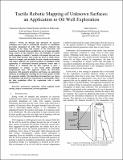Tactile robotic mapping of unknown surfaces: An application to oil well exploration
Author(s)
Mazzini, Francesco; Kettler, Daniel; Dubowsky, Steven; Guerrero, Julio Cesar
DownloadMazzini-2009-Tactile robotic mapping of unknown surfaces An application to oil well exploration.pdf (1.083Mb)
PUBLISHER_POLICY
Publisher Policy
Article is made available in accordance with the publisher's policy and may be subject to US copyright law. Please refer to the publisher's site for terms of use.
Terms of use
Metadata
Show full item recordAbstract
World oil demand and advanced oil recovery techniques have made it economically attractive to rehabilitate previously abandoned oil wells. This requires relatively fast mapping of the shape and location of the down-hole well structures. Practical factors prohibit the use of visual and other range sensors in this situation. Here, the feasibility of robotic tactile mapping is studied. A method is developed that only uses the robot joint encoders and avoids any force or tactile sensor, which are complex and unreliable in such a hostile environment. This paper addresses the general problem of intelligent tactile exploration of constrained internal geometries where time is critical. It is assumed that the time required to move a manipulator to acquire a new touch point outweighs computational time. This approach models the down-hole structures with geometric primitives and focuses on exploration efficiency by intelligently searching for new touch points to build the geometric models. The algorithms developed here are shown in simulations and hardware experiments to substantially reduce the data acquisition effort for exploration with a tactile manipulator.
Date issued
2009-12Department
Massachusetts Institute of Technology. Department of Mechanical EngineeringJournal
IEEE International Workshop on Robotic and Sensors Environments, 2009. ROSE 2009.
Publisher
Institute of Electrical and Electronics Engineers
Citation
Mazzini, F. et al. “Tactile robotic mapping of unknown surfaces: an application to oil well exploration.” Robotic and Sensors Environments, 2009. ROSE 2009. IEEE International Workshop on. 2009. 80-85. © Copyright 2010 IEEE
Version: Final published version
Other identifiers
INSPEC Accession Number: 11022494
ISBN
978-1-4244-4777-0